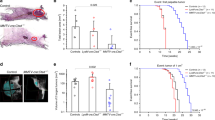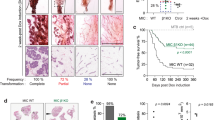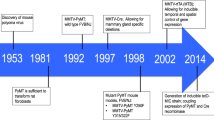Abstract
Expression levels of the papain-like cysteine protease cathepsin B (Ctsb) have been positively correlated with mammary tumour progression and metastasis; however, its roles in the hallmark processes of malignant growth remain poorly defined. Using Ctsb-deficient mice we investigated tumour cell differentiation, proliferation and apoptosis in the Tg(MMTV-PyMT) mouse mammary cancer model. Absence of Ctsb significantly impaired development of high-grade invasive ductal carcinomas and reduced the metastatic burden in the lungs. Mice lacking Ctsb exhibited reduced cell proliferation in mammary carcinomas and their lung metastases. Notably, intravenous injection of primarily isolated, Ctsb-expressing tumour cells into congenic Ctsb-deficient mice revealed impaired cell proliferation in the resulting experimental lung metastases, providing evidence for the involvement of Ctsb in paracrine regulation of cancer cell proliferation. No Ctsb genotype-dependent difference in tumour cell death was observed in vivo or by treatment of isolated PyMT cancer cells with tumour necrosis factor-α. However, cancer cells lacking Ctsb exhibited significantly higher resistance to apoptosis induction by the lysosomotropic agent Leu-Leu-OMe. Thus, our results indicate an in vivo role for Ctsb in promoting cellular anaplasia in mammary cancers and proliferation in lung metastases.
This is a preview of subscription content, access via your institution
Access options
Subscribe to this journal
Receive 50 print issues and online access
$259.00 per year
only $5.18 per issue
Buy this article
- Purchase on Springer Link
- Instant access to full article PDF
Prices may be subject to local taxes which are calculated during checkout





Similar content being viewed by others
References
Blomgran R, Zheng L, Stendahl O . (2007). Cathepsin-cleaved Bid promotes apoptosis in human neutrophils via oxidative stress-induced lysosomal membrane permeabilization. J Leukoc Biol 81: 1213–1223.
Cirman T, Oresic K, Mazovec GD, Turk V, Reed JC, Myers RM et al. (2004). Selective disruption of lysosomes in HeLa cells triggers apoptosis mediated by cleavage of Bid by multiple papain-like lysosomal cathepsins. J Biol Chem 279: 3578–3587.
de Visser KE, Coussens LM . (2006). The inflammatory tumor microenvironment and its impact on cancer development. Contrib Microbiol 13: 118–137.
Elston CW, Ellis IO . (1991). Pathological prognostic factors in breast cancer. I. The value of histological grade in breast cancer: experience from a large study with long-term follow-up. Histopathology 19: 403–410.
Fehrenbacher N, Gyrd-Hansen M, Poulsen B, Felbor U, Kallunki T, Boes M et al. (2004). Sensitization to the lysosomal cell death pathway upon immortalization and transformation. Cancer Res 64: 5301–5310.
Fernandez PL, Farre X, Nadal A, Fernandez E, Peiro N, Sloane BF et al. (2001). Expression of cathepsins B and S in the progression of prostate carcinoma. Int J Cancer 95: 51–55.
Frosch BA, Berquin I, Emmert-Buck MR, Moin K, Sloane BF . (1999). Molecular regulation, membrane association and secretion of tumor cathepsin B. APMIS 107: 28–37.
Gocheva V, Joyce JA . (2007). Cysteine cathepsins and the cutting edge of cancer invasion. Cell Cycle 6: 60–64.
Gocheva V, Zeng W, Ke D, Klimstra D, Reinheckel T, Peters C et al. (2006). Distinct roles for cysteine cathepsin genes in multistage tumorigenesis. Genes Dev 20: 543–556.
Guicciardi ME, Deussing J, Miyoshi H, Bronk SF, Svingen PA, Peters C et al. (2000). Cathepsin B contributes to TNF-alpha-mediated hepatocyte apoptosis by promoting mitochondrial release of cytochrome c. J Clin Invest 106: 1127–1137.
Guy CT, Cardiff RD, Muller WJ . (1992). Induction of mammary tumors by expression of polyomavirus middle T oncogene: a transgenic mouse model for metastatic disease. Mol Cell Biol 12: 954–961.
Huveneers S, van den Bout I, Sonneveld P, Sancho A, Sonnenberg A, Danen EH . (2007). Integrin alpha v beta 3 controls activity and oncogenic potential of primed c-Src. Cancer Res 67: 2693–2700.
Jaattela M . (2004). Multiple cell death pathways as regulators of tumour initiation and progression. Oncogene 23: 2746–2756.
Jedeszko C, Sloane BF . (2004). Cysteine cathepsins in human cancer. Biol Chem 385: 1017–1027.
Lechner AM, Assfalg-Machleidt I, Zahler S, Stoeckelhuber M, Machleidt W, Jochum M et al. (2006). RGD-dependent binding of procathepsin × to integrin alphavbeta3 mediates cell-adhesive properties. J Biol Chem 281: 39588–39597.
Lin EY, Jones JG, Li P, Zhu L, Whitney KD, Muller WJ et al. (2003). Progression to malignancy in the polyoma middle T oncoprotein mouse breast cancer model provides a reliable model for human diseases. Am J Pathol 163: 2113–2126.
Loffek S, Zigrino P, Mauch C . (2006). Tumor-stroma interactions: their role in the control of tumor cell invasion and metastasis. J Dtsch Dermatol Ges 4: 496–502.
McKerrow JH, Bhargava V, Hansell E, Huling S, Kuwahara T, Matley M et al. (2000). A functional proteomics screen of proteases in colorectal carcinoma. Mol Med 6: 450–460.
Mohamed MM, Sloane BF . (2006). Cysteine cathepsins: multifunctional enzymes in cancer. Nat Rev Cancer 6: 764–775.
Mueller MM, Fusenig NE . (2004). Friends or foes—bipolar effects of the tumour stroma in cancer. Nat Rev Cancer 4: 839–849.
Nagaraj NS, Vigneswaran N, Zacharias W . (2007). Hypoxia inhibits TRAIL-induced tumor cell apoptosis: involvement of lysosomal cathepsins. Apoptosis 12: 125–139.
Podgorski I, Sloane BF . (2003). Cathepsin B and its role(s) in cancer progression. Biochem Soc Symp: 12: 263–276.
Rossi A, Deveraux Q, Turk B, Sali A . (2004). Comprehensive search for cysteine cathepsins in the human genome. Biol Chem 385: 363–372.
Rozhin J, Sameni M, Ziegler G, Sloane BF . (1994). Pericellular pH affects distribution and secretion of cathepsin B in malignant cells. Cancer Res 54: 6517–6525.
Sanchez-Beato M, Sanchez-Aguilera A, Piris MA . (2003). Cell cycle deregulation in B-cell lymphomas. Blood 101: 1220–1235.
Sloan EK, Pouliot N, Stanley KL, Chia J, Moseley JM, Hards DK et al. (2006). Tumor-specific expression of alphavbeta3 integrin promotes spontaneous metastasis of breast cancer to bone. Breast Cancer Res 8: R20.
Sloane BF, Rozhin J, Johnson K, Taylor H, Crissman JD, Honn KV . (1986). Cathepsin B: association with plasma membrane in metastatic tumors. Proc Natl Acad Sci USA 83: 2483–2487.
Stoka V, Turk B, Schendel SL, Kim TH, Cirman T, Snipas SJ et al. (2001). Lysosomal protease pathways to apoptosis. Cleavage of bid, not pro-caspases, is the most likely route. J Biol Chem 276: 3149–3157.
Stoka V, Turk B, Turk V . (2005). Lysosomal cysteine proteases: structural features and their role in apoptosis. IUBMB Life 57: 347–353.
Turk B, Stoka V . (2007). Protease signalling in cell death: caspases versus cysteine cathepsins. FEBS Lett 581: 2761–2767.
Turk B, Turk D, Turk V . (2000). Lysosomal cysteine proteases: more than scavengers. Biochim Biophys Acta 1477: 98–111.
van Roozendaal KE, Klijn JG, van Ooijen B, Claassen C, Eggermont AM, Henzen-Logmans SC et al. (1996). Differential regulation of breast tumor cell proliferation by stromal fibroblasts of various breast tissue sources. Int J Cancer 65: 120–125.
Vasiljeva O, Papazoglou A, Kruger A, Brodoefel H, Korovin M, Deussing J et al. (2006). Tumor cell-derived and macrophage-derived cathepsin B promotes progression and lung metastasis of mammary cancer. Cancer Res 66: 5242–5250.
Vasiljeva O, Reinheckel T, Peters C, Turk D, Turk V, Turk B . (2007). Emerging roles of cysteine cathepsins in disease and their potential as drug targets. Curr Pharm Des 13: 385–401.
Zajc I, Hreljac I, Lah T . (2006). Cathepsin L affects apoptosis of glioblastoma cells: a potential implication in the design of cancer therapeutics. Anticancer Res 26: 3357–3364.
Zheng X, Chou PM, Mirkin BL, Rebbaa A . (2004). Senescence-initiated reversal of drug resistance: specific role of cathepsin L. Cancer Res 64: 1773–1780.
Acknowledgements
We thank Anne Schwinde, Susanne Dollwet-Mack, Anita Becker and Johanna Klupp for excellent technical assistance, and Professor/Dr Roger H Pain for critical reading of the paper. The work was supported by grant 23-7532.22-33-11/1 of the Ministerium fuer Wissenschaft und Kunst, Baden-Wuerttemberg, and the European Union Framework Programme 6, Project LSHC-CT-2003-503297, Cancer Degradome.
Author information
Authors and Affiliations
Corresponding author
Additional information
Supplementary Information accompanies the paper on the Oncogene website (http://www.nature.com/onc)
Supplementary information
Rights and permissions
About this article
Cite this article
Vasiljeva, O., Korovin, M., Gajda, M. et al. Reduced tumour cell proliferation and delayed development of high-grade mammary carcinomas in cathepsin B-deficient mice. Oncogene 27, 4191–4199 (2008). https://doi.org/10.1038/onc.2008.59
Received:
Revised:
Accepted:
Published:
Issue Date:
DOI: https://doi.org/10.1038/onc.2008.59



